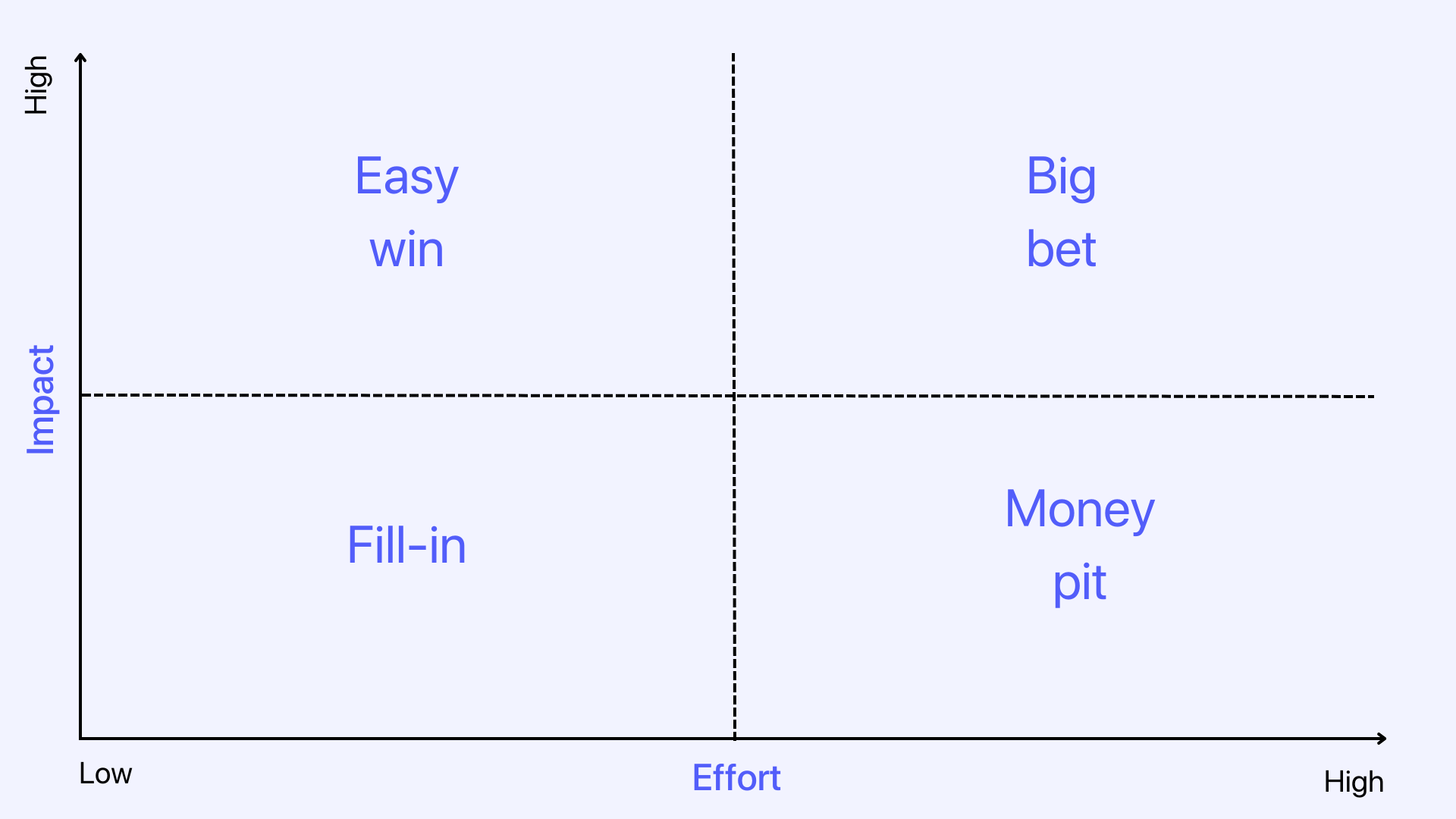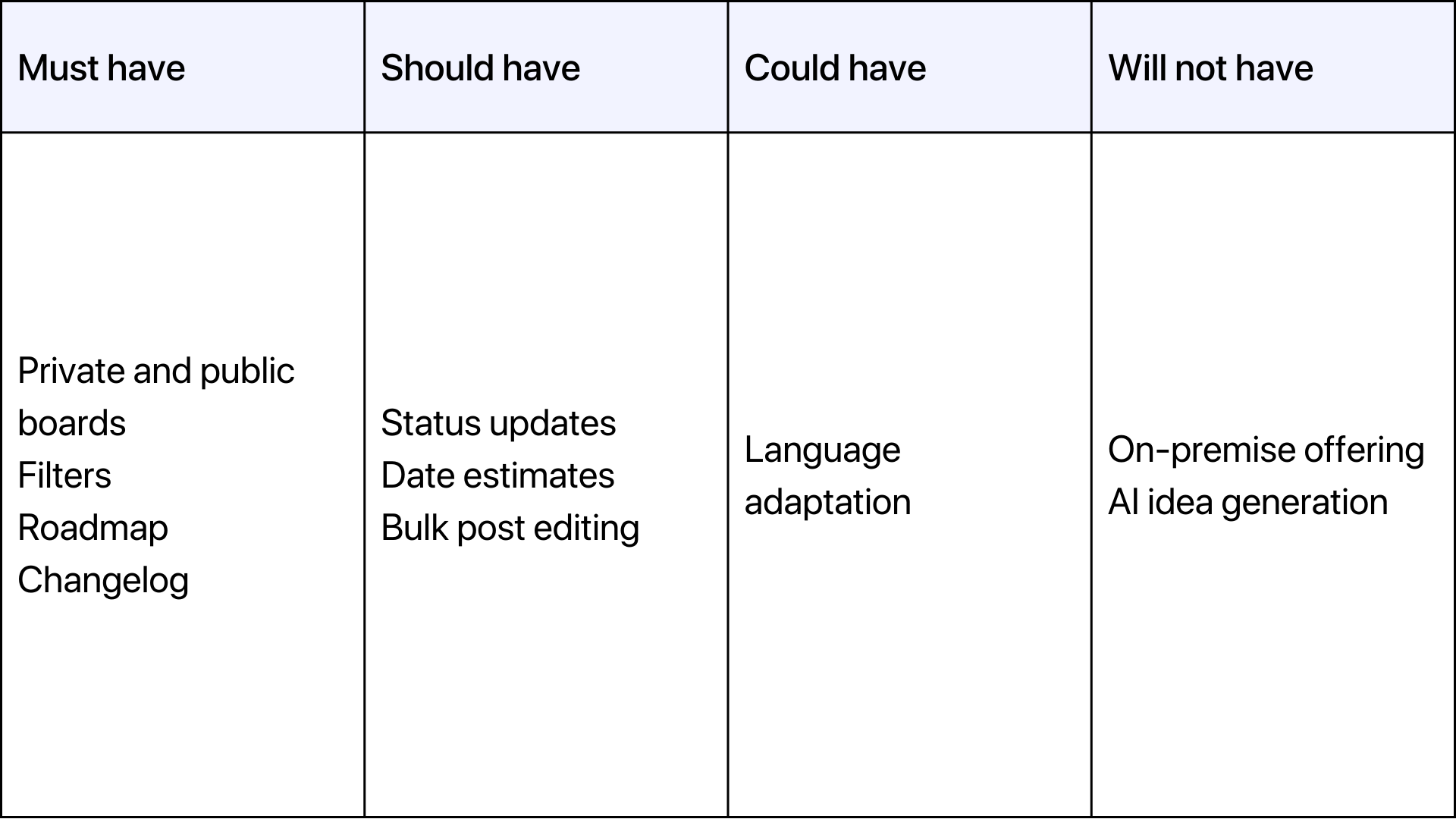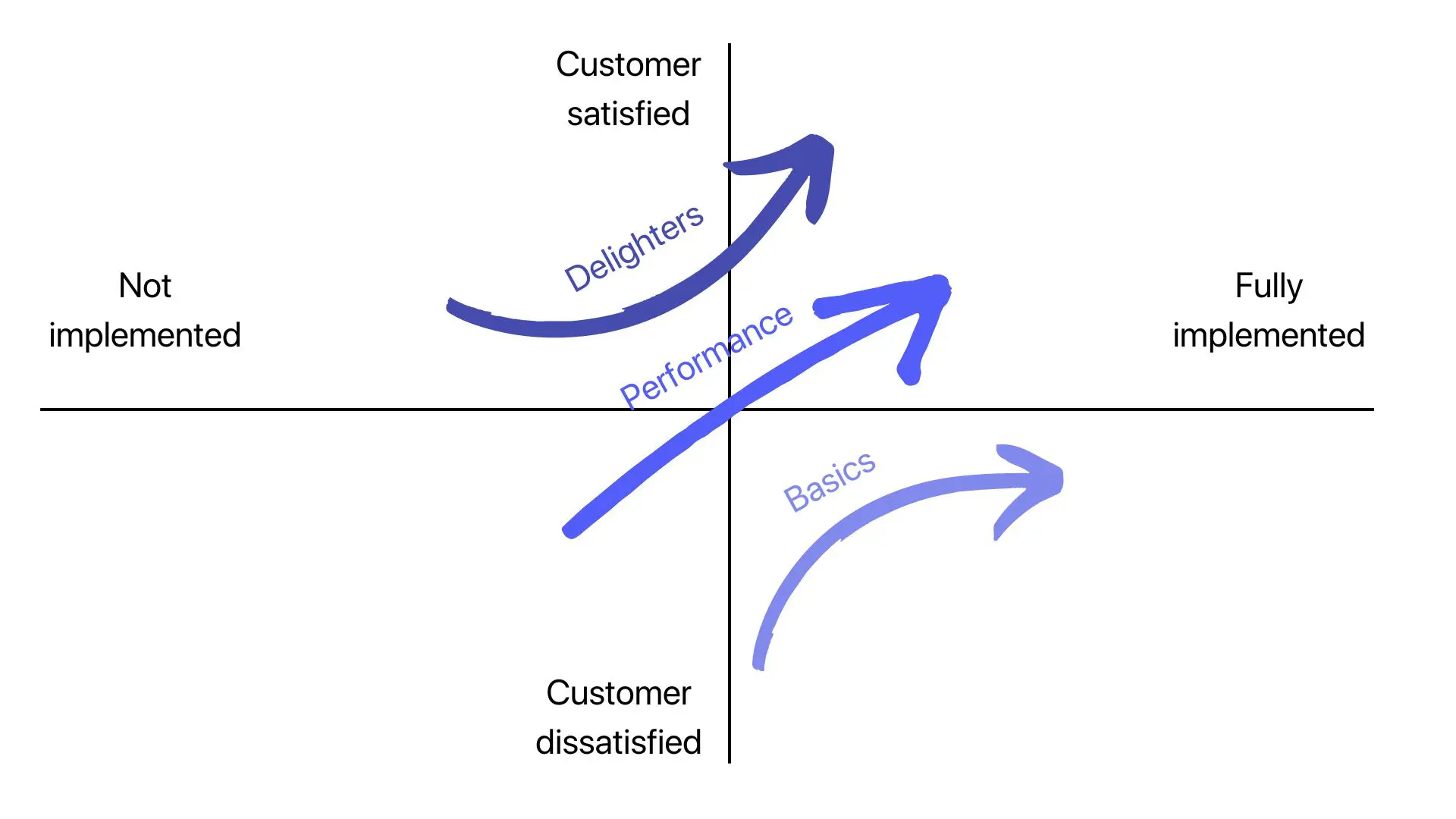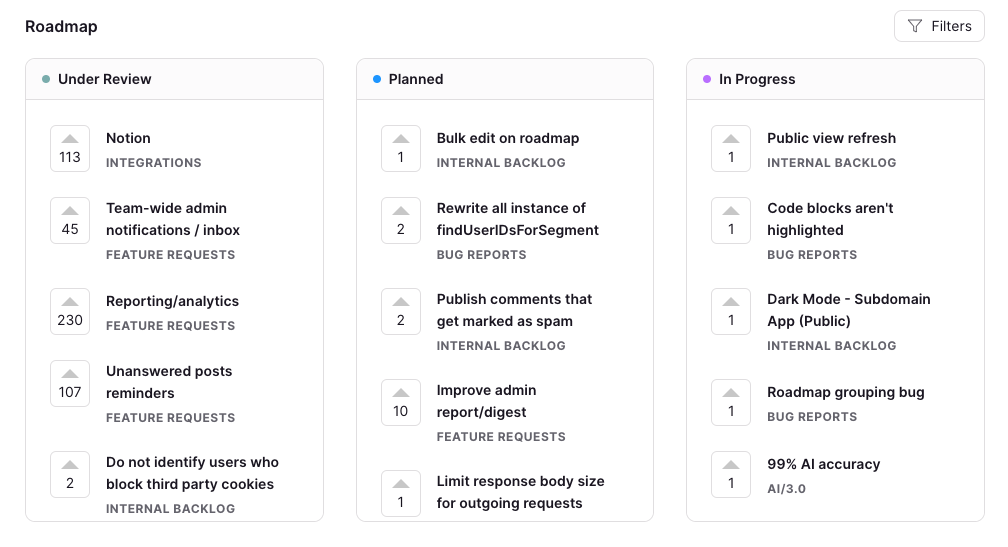Not every marketer knows what a marketing roadmap is. Chances are, you’re more familiar with marketing plans and business plans.
The purpose of a marketing plan is to outline strategies to achieve business objectives. Marketing roadmaps outline the steps necessary to implement these strategies over time.
The term roadmap is more popular in the context of strategy, product, and project roadmaps.
So what is a marketing roadmap?
A marketing roadmap isn’t just any plan. It’s outlines your goals, initiatives, and timelines for completing them. It’s more tactical than a marketing plan. But why does this matter?
In short, it can propel your business.
Imagine this:
- You’re finally able to prioritize your efforts effectively
- You can track progress with ease
- You can get alignment between all stakeholders in the blink of an eye
- Everyone knows exactly where they’re headed and how they’ll get there
Marketing is a broad discipline. It often involves lots of different initiatives. So staying organized gets tough. Marketing roadmaps help mitigate that. They help you stay organized around your strategic marketing initiatives.
So, let’s dive in! We’re about to explore everything to do with creating marketing roadmaps.
What is a marketing roadmap?
A marketing roadmap is more than just a fancy term. Think of it as your GPS while driving towards your team’s success. It’s a visual representation of your marketing initiatives. Here’s what it can do for you:
- It lays out all the stops (milestones)
- It shows you the routes (plans and tasks) to reach your destinations
- It indicates who’s responsible for which project
What makes a marketing roadmap effective?
Its ability to define what you want to achieve, how you’ll do it, and when.
Here’s an example: you want to increase brand awareness. So you build a digital marketing plan: blog posts, social media campaigns, etc.
Then, you add them to your roadmap. You specify what projects will be worked on and when. Who is involved? What does success look like? It’s all there. And, your team is focused on tackling these projects as laid out.
Note: you could even branch out your marketing roadmap into a digital marketing roadmap. This makes a lot of sense if your marketing team is large and you plan on having lots of marketing campaigns. You can create many marketing roadmaps that plot your course in many different areas. You might even build campaign specific roadmaps for critical projects.
Benefits of a marketing roadmap
A marketing roadmap can be your best friend. It’s like having a GPS for your organization’s marketing initiatives. Here are some of the benefits it provides:
- Clear vision and direction: It provides a clear vision of what the marketing team aims to achieve. It also outlines the steps required to get there. This clarity helps to align the team’s efforts towards common goals.
- Prioritization: With a roadmap, marketing teams can prioritize tasks, campaigns, and initiatives. Factors can include importance, potential impact, and alignment with the company’s overall objectives.
- Resource allocation: It helps to manage things like budget, manpower, time, and other resources. This ensures the most critical projects get the necessary attention.
- Flexibility: A roadmap provides a structured plan, but it’s also flexible. If market conditions change or new opportunities arise, teams can adjust their plans while still staying on track.
- Performance tracking: Roadmap helps set deadlines and milestones. Teams can track their progress and stay on track.
- Risk management: Potential bottlenecks, conflicts, or resource shortages surface earlier. It’s easier to address them.
- Long-term perspective: Daily tasks and immediate concerns are important. But a roadmap helps teams to also focus on long-term goals and the bigger picture.
A marketing roadmap acts as that guide. It makes sure all team members are heading in the same direction.
As a result, marketing roadmaps help you make better decisions. That’s because you’ll know where you’re going. And this will reduce wasted time and resources caused by confusion or lack of clear strategy.
Components of a marketing roadmap
A marketing roadmap isn’t just any chart or document. It’s the tactical wing of your marketing strategy, outlining the steps to success.
After you’ve done some preliminary research, you know your goals and your target market. Now it’s time to lay out your activities. Let’s delve deeper into its key elements.
Initiatives
These could be projects, specific tactics, or campaigns. It’s important to organize these tasks the way that makes the most sense to you and your team.
Goals
You may want to include a goal for each initiative. This will help you tie your marketing initiatives to your overall objectives.
Timelines
Your roadmap needs timelines. Specific dates indicate when each action item should start and finish. They also ensure everyone knows what they’re responsible for. This prevents delays down the line.
Status
Display the status of each item to keep everyone aligned. You can use statuses like:
- To do
- Planned
- In progress
- Blocked
- In review
- Complete
Customize them based on your preference.
Owners
“Wait, who’s working on this campaign?”. This happens way too often. Let’s avoid this confusion by assigning owners to each item.
Types of marketing roadmaps
Depending on how you plan out your marketing activities, you can separate your roadmaps into:
- Strategy roadmap – how marketing initiatives work with your overarching goals
- Portfolio roadmap – how various products are marketed
- Activities roadmap – how each tactic is going to play out
- Project/campaign roadmap – if you have a large project or a big launch
- Technology roadmap — maps out the technologies you need to implement for your marketing roadmap
Marketing roadmaps formats
How can you lay out your marketing roadmaps? We’ve seen examples using:
- Checklists
- Spreadsheets
- Calendars
- Kanbam boards
- Gantt charts
- A dedicated roadmap tool
Let’s talk about actually creating a marketing roadmap now.
Developing a marketing roadmap
Creating an effective marketing roadmap isn’t just about plotting out tasks. It’s like assembling a jigsaw puzzle – every component has its own designated spot and meaning.
This process involves these critical steps.
Understand your starting point
The first step is to get a clear picture of your organization’s current state. It’s much like assessing the terrain before planning a hike. Here are a few things you can do in this initial step:
- Talk to your team
- Keep researching the market and your industry
- Go through and understand your SWOT analysis
- Adjust as needed
Determine future goals
Next up is defining what success looks like for your business in concrete terms (you might refer to a business roadmap). Ask yourself the following questions:
- Why are we creating this roadmap?
- What are the goals this roadmap will achieve?
- Is it for a product launch? Specific campaign?
- What’s the end state?
- What does success look like?
Consulting stakeholders
Who needs to be involved? Whose buy-in do we need? Figure it out in this step to avoid bottlenecks.
Getting organized
Determine what projects get you to your desired state. Here are some questions that can guide you here:
- What order should they be done in?
- How much time will they take?
- Who is responsible?
- What’s the deadline?
- What resources do we need?
Prioritizing
In marketing, you’ve got a sea of choices. Ads, emails, events, social media — you name it! But here’s the catch: you can’t sail every sea. Prioritization means choosing the right waves to ride to make the biggest splash with your brand. It’s about picking the marketing activities that will shout the loudest about your product without breaking the bank.
Here are a few ways to prioritize your marketing roadmap:
- Impact vs. effort: look at your marketing ideas. Ask two things: Will it make a big splash (impact)? Is it tough to do (effort)? Go for the big splashes that don’t need a superhero team to happen.

- MoSCoW method: some marketing projects are a must-have (like having a website). Others are great if you can swing them (like a fancy launch event). Choose wisely!

- Kano model: This one’s all about your customers. What marketing stuff do they expect (like regular posts on your social media)? What would surprise and thrill them (a pop-up event or giveaway)? Make them smile and trust your brand.

When planning your moves, think customer-first. What do they like? What grabs their attention? Use simple surveys or feedback forms to catch their thoughts. It’s like having a cheat sheet for your next big win.
Looking for more prioritization methods? Check out this blog post.
Making smart picks is your golden ticket. It’s not guessing; it’s about being a smart player.
Creating the roadmap
The final stage involves designing actions that will lead you towards those objectives. Think of it as mapping out the best trail to reach your destination atop Mount Success.
Here’s where platforms like ClickUp or Asana come in handy. They can help manage all aspects – from goals to owners.
Alternately, you might choose to use a dedicated roadmapping tool like Canny. It lets you create a visual roadmap with your planned, in progress, and shipped projects.

Start with these free roadmap templates and find out which layout works best for you!
Note: remember – flexibility matters. Because detours may pop up along the way.
Once you’ve chosen the tool, follow these steps:
- Add ideas to your roadmap
- Score them based on the prioritization criteria you selected
- Ask for team’s input
- Set deadlines and timelines
- Assign responsibilities
- Break down larger tasks into smaller projects
- Connect related tasks and dependencies
- Add enough detail to each task: relevant links, ideas, feedback from the team, etc.
Implementing a marketing roadmap
Getting your marketing roadmap off the ground can feel like launching a rocket. But with proper organizing and precise articulation, it’s very doable.
Selecting clear communication channels
To start implementing your marketing roadmap, make sure everyone knows what’s going on. That means creating open lines of communication. Keep stakeholders informed about key initiatives, deadlines, and changes in direction. Transparency fosters trust among team members too. It ensures everyone is pulling in the same direction.
Monitoring progress regularly
Moving along the journey requires constant vigilance to stay on course. Make sure that projects are being completed within the scheduled timelines. Monitor progress against Key Performance Indicators (KPIs) regularly.
First, make sure you’re hitting deadlines. If not, assess why and what’s not working. Do you need more people to distribute the work? Is anyone overworked? Does anyone else have some spare time? Maybe some team members aren’t using their time effectively?
Next, zoom in on individual projects. What’s getting done and what isn’t? What’s top priority and what isn’t? What’s the underlying reason?
Finally, compare individual results to the roadmap’s objectives. Are you on track to achieve them? If not, how can you pivot?
Pivoting when necessary
Occasionally, roadmaps don’t work out as expected, and that’s alright. An initiative may not be delivering results. Or circumstances might change dramatically (like say…an unexpected global pandemic). In those cases, you need to be ready to pivot swiftly but smartly. Revisit goals and adjust timelines or resources as needed.
Remember: it takes collaboration from all sides. Marketers, designers, developers, and anyone else who has a stake in the game. When everyone’s aligned on a mutual goal, pivoting will be easier. And this will ensure a successful implementation of your marketing roadmap (even if you steer off course).
Why do you need a marketing roadmap?
So, you’ve navigated the twists and turns of understanding what a marketing roadmap is. You’ve seen how it’s more than just a plan.
You now know its immense value in:
- Prioritizing initiatives
- Tracking progress
- Ensuring alignment across all stakeholders.
Remember though: building marketing roadmaps requires careful planning. Review your roadmap and regularly. This will keep things on track and optimize performance along the way.
In short: what is a marketing roadmap? It’s a tactical tool that helps you implement your marketing plans, strategies, and campaigns. So start planning!
P.S. Looking for an easier way to stay organized? Check out our roadmap templates here!







